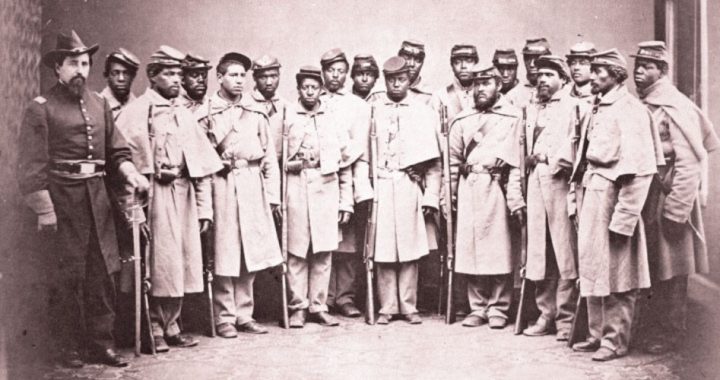
A freed slave and tenant farmer, Roda Ann Childs of Griffin, Georgia, testified on September 25, 1866 before the Freedman’s Bureau in her state of what happened when eight armed men barged into her home one evening:
We were called upon one night, and my husband was demanded; I said he was not there. They then asked where he was. I said he was gone to the watermelon patch. They then seized me and took me some distance from the house, where they “bucked” me down across a log, stripped my clothes over my head, one of the men standing astride my neck, and beat me across my posterior, two men holding my legs. In this manner I was beaten until they were tired. Then they turned me parallel with the log, laying my neck on a limb which projected from the log, and one man placing his foot upon my neck, beat me again on my hip and thigh. Then I was thrown upon the ground on my back, one of the men stood upon my breast, while two others took hold of my feet and stretched my limbs as far apart as they could, while the man standing upon my breast applied the strap to my private parts until fatigued into stopping, and I was more dead than alive. Then a man, supposed to be an ex-confederate soldier, as he was on crutches, fell upon me and ravished me. During the whipping one of the men ran his pistol into me, and said he had a hell of a mind to pull the trigger, and swore they ought to shoot me, as my husband had been in the “God d***ed Yankee Army,” and swore they meant to kill every black son-of-a-b***h they could find that had ever fought against them. They then went back to the house, seized my two daughters and beat them, demanding their father’s pistol, and upon failure to get that, they entered the house and took such articles of clothing as suited their fancy, and decamped.
Mrs. Childs’ husband had been entitled to own a gun as a soldier in the Union army during the war, but pre-war Georgia law had banned even free blacks from owning guns. Such laws threatened to leave millions of newly freed slaves to the ravages of savage men, some of whom worked with local police, others who worked openly in unofficial gangs, and still others who worked secretly behind the white sheets of the Ku Klux Klan.
Already by 1866, the carnage suffered by black Americans was massive, numbering in the thousands across the former slave states. Former Mississippi Provisional Governor William L. Sharkey — a pre-war Supreme Court judge in the state and unionist during the war — testified before Congress in 1866, “I believe that there are now in the State very little over half the number of freedmen that there were formerly of slaves — certainly not more than two-thirds. They have died off. There is no telling the mortality that has prevailed among them; they have died off in immense numbers.” Sharkey — whose numbers are clearly exaggerated unless they include refugees who fled the state — concluded to Congress, “My expectation concerning them is that they are destined to extinction, beyond all doubt. We must judge of the future by the past. I could tell you a great many circumstances to that effect; I am sorry I did not come prepared with means to state the percentages of deaths among them. It is alarming, appalling. I think they will gradually die out.”
Sharkey — who had been appointed governor by President Andrew Johnson and elected in 1865 to the U.S. Senate by Mississippi (but not seated because the Reconstructionist Congress refused to seat congressmen from confederate states) — wasn’t the only one to predict extermination of African-Americans in the postwar environment. Rev. Joseph E. Roy of the American Home Missionary Society told Congress of his six-month-long mission across the South after the war: “I heard very many persons remark, with great satisfaction, that the negroes would become extinct in a few years,” including many people willing to do the job themselves.
That “extinction” could only take place if the armed African-Americans who had been in Union army service were first disarmed, a movement well under way by the time of Mrs. Childs’ brutal rape. South Carolina Freedman’s Bureau official Assistant Commissioner Rufux Saxton testified before Congress in 1866 that he also had documented numerous attempts by white supremacist gangs, calling themselves “regulators,” roving about South Carolina to disarm black freedmen. “I have had men come to my office and complain that the negroes had arms, and I also heard that [a] band of men called Regulators, consisting of those who had been in the late confederate service, were going around the country disarming negroes. I can further state that they desired me to sanction a form of contract that would deprive the colored men of their arms, which I refused to do.”
America’s First Racist Gun Control Laws
The very first gun control laws in America were slave codes that banned African-Americans from owning or bearing arms. As early as 1640, the Virginia legislature passed an ordinance stating that African-American slaves — then numbering fewer than 300 in the British colony — would be exempt from mandatory militia service. The Virginia slave code of 1680 made disarmament of all black people mandatory, ruling, “It shall not be lawfull for any negroe or other slave to carry or arme himselfe with any club, staffe, gunn, sword or any other weapon of defence or offence,” a prohibition repeated in the 1705 Virginia slave code, written in more modern language, requiring that “no slave go armed with gun, sword, club, staff, or other weapon.”
The prohibition against slaves owning or carrying guns or other weapons in Britain’s American colonies preceded other gun control laws across the British empire, including the penal laws against the Irish, which in 1695 required that “All papists [Catholics] within this kingdom of Ireland shall before the 1st day of March, 1696, deliver up to some justice of the peace or corporation officer where such papist shall dwell, all their arms and ammunition, notwithstanding any licence for keeping the same heretofore granted.”
The rules against owning guns were aimed not just at those nominally deemed “slaves” in America; they were aimed at all subjected peoples. The text of Virginia’s first slave code applied the same restriction to “free” blacks and indentured servants (mostly Irish Catholics and Scotch Presbyterians, but also criminals). Nearly all other Southern slave-holding states copied Virginia’s lead, passing laws banning the ownership of guns for both slave and free African-Americans. These laws stayed in effect and were updated after independence from Britain. Georgia’s 1833 slave code required that “the free persons of color, so detected in owning, using or carrying fire-arms, shall receive on his bare back, thirty-nine lashes.” Alabama’s 1833 slave code was nearly identical, with exactly the same punishment. North Carolina’s 1855 slave code simply stated: “No slave shall go armed with gun, sword, club or other weapon, or shall keep any such weapon.” The state omitted the mention of free blacks, largely because North Carolina had so few free African-Americans.
Texas may have been alone among slave states not to pass an outright ban on slaves bearing arms, perhaps in part due to legislative fidelity to the 1836 state constitution that mandates, “Every citizen shall have the right to bear arms in defence of himself and the republic.” Though blacks were not considered citizens in antebellum Texas, the legislature was assumed not to have the power to pass legislation prohibiting any ownership of guns.
The reason slave codes denied the right to keep and bear arms to slaves is easily understandable. The whites feared the slaves would rebel. Arming slaves may have led to a revolution the slave-masters did not want. But that didn’t explain the ban on free blacks owning guns. The deeper purpose behind the ban on owning and bearing arms was to take away any thought that those people had individual rights. And it went far beyond the practical denial of a long-held individual right among Anglo-American people; the deeper issue had to do with placing the master as a god above the slave, with the power of life and death.
This point was brought home in the 1830 case of North Carolina v. Mann, when the Supreme Court of North Carolina defended the right of a master who had shot his slave named Lydia while she was trying to run away. The case established that slavery was less about labor than about dehumanizing power. “The slave, to remain a slave,” Justice Thomas Ruffin wrote in his decision, “must be made sensible, that there is no appeal from his master; that his power is in no instance, usurped; but is conferred by the laws of man at least, if not by the law of God.” The words of Ruffin blasphemously perverted the words of St. Paul in Chapter 13 of his Letter to the Romans: “Let every soul be subject to higher powers: for there is no power but from God: and those that are, are ordained of God. Therefore he that resisteth the power, resisteth the ordinance of God … for he beareth not the sword in vain. For he is God’s minister: an avenger to execute wrath upon him that doth evil.”
Ruffin hadn’t really made any innovation of law in the antebellum South, as laws in many states implicitly — and sometimes explicitly — gave masters the power of life and death over their slaves. For example, Virginia’s slave code of 1705 stipulated that “if any slave resist his master, or owner, or other person, by his or her order, correcting such slave, and shall happen to be killed in such correction, it shall not be accounted felony; but the master, owner, and every such other person so giving correction, shall be free and acquit of all punishment and accusation for the same, as if such accident had never happened.” In early America, slavery quickly came to be divided between traditional slavery practiced in almost every nation and culture — what the English sometimes called “indentured servitude” and today is called “white slavery” — and the “chattel” slavery that bound African-Americans. The distinction became a gulf by the mid-1700s, as indentured servants traditionally had some rights and were generally only bound for a limited time (and this system was abolished after the War for Independence from Britain). African-American “chattel” slavery — a word that means “moveable property” and is derived from the English word “cattle” — was for the life of the slaves and all of their descendants. In such a system, it was vital the slave-owner be the only one bearing the “sword,” and to be the god-figure with the power of life and death over the slave.
The ban on ownership of guns by nominally free African-Americans in most states had the same purpose as slavery. In essence, a ban on ownership of weapons is the ultimate badge of slavery and inferiority to the higher power that bears the “sword.” Whether it was the “free” African-Americans in Virginia or the Irish tenant under penal laws as an indentured servant, the purpose behind gun control was to keep them in a state of slavery with or without the name.
Establishing the right to keep and bear arms was a key fight in the Anglo-American tradition, and an important part of the English Bill of Rights signed by William of Orange in 1689. That document stipulated “the subjects which are Protestants may have arms for their defence suitable to their conditions and as allowed by law.” The document was a predecessor of the U.S. Second Amendment, the former passed in part because the deposed Catholic King James II had deprived some Protestants of weapons. The British Bill of Rights complained James II had caused “several good subjects being Protestants to be disarmed at the same time when papists were both armed and employed contrary to law.”
Persons possessing rights have historically been capable of owning and bearing arms, while slaves have not. The complete subjugation of all blacks — whether “free” or slave — was driven home by Supreme Court Chief Justice Roger Taney in the infamous Dred Scott case in 1856. Taney stressed in his Dred Scott v. Sandford opinion that if African-Americans could be admitted as citizens in any state, “It would give to persons of the negro race, who were recognised as citizens in any one State of the Union, the right … to keep and carry arms wherever they went.” Taney correctly noted that even in some Northern U.S. states, blacks were denied the right to keep and bear arms. “By the laws of New Hampshire, collected and finally passed in 1815,” Taney wrote, “no one was permitted to be enrolled in the militia of the State but free white citizens, and the same provision is found in a subsequent collection of the laws made in 1855. Nothing could more strongly mark the entire repudiation of the African race.” Not surprisingly, blacks had few rights in those Northern states before the Civil War — being without the right to keep and bear arms — and were reduced in many instances to a state of near-slavery.
In his Dred Scott opinion, Taney also claimed, falsely, that African-Americans were denied both citizenship and the right to keep and bear arms in every state, a point Associate Justice Benjamin Curtis refuted in his dissent. Taney wrote of blacks in his decision: “We think they are not, and that they are not included, and were not intended to be included, under the word ‘citizens’ in the Constitution, and can therefore claim none of the rights and privileges which that instrument provides for and secures to citizens of the United States.”
But the reality was that blacks were considered full citizens in Massachusetts before adoption of the U.S. Constitution, and in Vermont as soon as it joined the union. Shortly after Massachusetts ratified its 1780 constitution declaring that “all men are born free and equal,” the state courts were beset with slaves demanding their freedom under that provision of the constitution.
The state constitution deemed them “free and equal,” protecting for them all the rights possessed by white people, including both the right to vote and the right to keep and bear arms. In fact, Revolutionary War veteran and freed slave Toby Gilmore owned a cannon on his Raynham, Massachusetts, farm and, according to local tradition, publicly fired it off during annual Fourth of July celebrations. Gilmore’s cannon — which stands as a thundering refutation of today’s gun control lobby argument that the Founding Fathers did not intend the Second Amendment to protect citizen ownership of “military-style assault weapons” — currently resides in the Old Colony Historical Society in Taunton, Massachusetts.
Black Codes After the Civil War
Even after abolition of slavery with the 13th Amendment, racist gun control laws were used to keep African-Americans in a state of subjugation. Across the former Confederate states, reconstituted legislatures in 1865 passed laws designed to reduce the status of African-Americans back to slaves without the name. These laws became known as the “Black Codes,” and even some of the Northern states — such as Oregon — enforced Black Codes for decades. In the South, many of the old slave codes were simply re-enacted, with the word “slave” struck out and “negro” or “freeman” inserted. Most also passed apprenticeship and vagrancy laws that placed African-Americans in long-term, forced agricultural contracts unless they carried work papers with a plantation.
Even their right to freedom of worship was taken from them under the infamous Black Codes. Ever since the abortive Gabriel Prosser slave revolt in Virginia in 1800, organized under the auspices of religious meetings, slave codes restricted black people’s religious gatherings. Mississippi’s Black Codes of 1865 likewise prohibited African-Americans from “exercising the function of a minister of the Gospel without a license from some regularly organized church.” Freedman’s Bureau Assistant Commissioner Thomas Conway testified to Congress on February 22, 1866 that in Louisiana, religious meetings were often broken up under a similar law that banned religious meetings after 9:00 in the evening: “There was an order issued at all the station-houses of the city, that the police in their various beats should break up any meetings of colored people held after 9 o’clock, and in some places meetings were broken up and the worshipers were all carried off to jail. This was done violently, and, on account of it, the city was almost reduced to a state of riot and revolution, the colored people having been unwilling to endure the persecution.”
But there was no armed resistance, since only the white population possessed guns. And the recently freed population of ex-slaves were often slaughtered by new secret societies bent on terrorism and murder, such as the Ku Klux Klan and the White Leagues (and after 1875, the less secret Red Shirts).
Mississippi’s Black Codes provided a $10 fine (about $650 in today’s money) for black ownership or possession of guns, but in Florida the penalty for an African-American owning a gun was positively medieval. Florida stipulated that black gun owners would be required to “stand in the pillory … for one hour, and then whipped with thirty-nine lashes on the bare back.” Thirty-nine lashes was also the standard penalty under slave codes in many of the Southern states for gun ownership. South Carolina also prescribed “corporal punishment” for blacks owning guns.
Even African-American soldiers on duty in the U.S. Army were subject to persecution under the Black Codes. Conway also testified of vagrancy laws: “In the city of New Orleans last summer [1865], under the orders of the acting mayor of the city, Hugh Kennedy, the police of that city conducted themselves toward the freedmen, in respect to violence and ill usage, in every way equal to the old days of slavery; arresting them on the streets as vagrants, without any form of law whatever, and simply because they did not have in their pockets certificates of employment from their former owners or other white citizens. I have gone to the jails and released large numbers of them, men who were industrious and who had regular employment; yet because they had not the certificates of white men in their pockets they were locked up in jail to be sent out to plantations…. Some members of the seventy-fourth United States colored infantry, a regiment which was mustered out but one day, were arrested the next because they did not have these certificates of employment. This was done to these men after having served in the United States army three years.”
Some Relief Under the 14th Amendment
When the 14th Amendment was declared ratified in 1868 (the reconstructionist Congress forced former Confederate states to ratify it as a condition of renewing congressional representation), the Black Codes — including the race-based prohibition of keeping and bearing arms — became instantly unconstitutional. The amendment granted citizenship to blacks and stipulated that no state could “deprive any person of life, liberty, or property, without due process of law; nor deny to any person within its jurisdiction the equal protection of the laws.”
The amendment required at least nominal equality under the law, but attempts to prohibit black citizens from obtaining firearms for their self-defense continued under new Jim Crow laws. Dubbed “separate but equal” by its proponents, only the first half of the proposition under Jim Crow was ever designed to be true. The new racist laws in many states took on a nominally even-handed appearance, even though they were designed to subjugate black Americans. In order to stop blacks from voting, a literacy test was enacted in many of the Southern states where it had been a crime for decades to teach slaves how to read. And to ensure that illiterate whites could continue to vote uninterrupted, the same legislatures enacted the “grandfather clause.” The grandfather clause stated that if a person or his father or grandfather could vote in the United States before 1860, they wouldn’t have to take the literacy test in order to vote. In other words, the literacy test would only apply to blacks.
That’s how Jim Crow worked toward disarming black Americans. A year after Homer Plessy, who was black, was arrested for boarding a segregated white train car in Louisiana in the famous case that eventually added a Supreme Court imprimatur upon Jim Crow, Florida passed a law that incorporated gun control into Jim Crow by prohibiting the carrying of handguns and repeating rifles without a license. And just as Homer Plessy paid extra for a ticket to the first-class car and was told there was no first-class car for African-Americans, the “separate but equal” gun control laws were likewise only half true because they weren’t applied equally. Florida Justice Rivers Buford’s concurring opinion Watson v. Stone (1941) stated of the 1893 law: “The original act was passed when there was a great influx of Negro laborers … and the Act was passed for the purpose of disarming the Negro laborers…. The statute was never intended to be applied to the white population and in practice has never been so applied.” The law was set aside in the 1941 Florida court decision, but not because of its racism.
In the history of gun control elsewhere across the globe, there have been many examples of genocide where the victim race or ethnic group has been disarmed before the genocide took place. One particularly valuable scholarly analysis of this trend was the 1994 book Lethal Laws by Jay Simkin, Alan Rice, and Aaron Zelman, which analyzed the gun control laws of six national genocides. In each of the six cases, from the Turkish slaughter of the Armenians to the Nazi annihilation of the Jews to the Rwandan Hutus killing the Tutsis, strict gun control laws were in place for the victim populations before the genocide. America avoided genocide, but historically its gun control laws served a similar racist purpose by subjugating African-Americans legally and leaving them to the ravages of terrorist organizations such as the Red Shirts and the Ku Klux Klan.
Photo: encyclopediavirginia.org
This article is an example of the exclusive content that’s only available by subscribing to our print magazine. Twice a month get in-depth features covering the political gamut: education, candidate profiles, immigration, healthcare, foreign policy, guns, etc. Digital as well as print options are available!



